Last updated on April 24th, 2024
Featured image: Monument to Mother Teresa / Photo by PhotoChur on Adobe Stock
One woman’s journey to healing through service
By Amanda Burgess
This is a story of hope. A story of possibilities. A story of tapping into the power we all have to impact another person’s life. Of finding purpose in our lives. So often, we think our words and actions are meaningless, but here’s the truth: If we move with love instead of fear, we change lives.
In 1989, 32-year-old Suzanne Lapensee was preparing to attend a tournament in Malta with a Canadian National Team as one of its athletic therapists. It was a low point in her life. She mailed a letter to her friends and family to say she was leaving for the tournament and didn’t know when she’d be back. After the tournament, she travelled solo from Malta to Cyprus, to Italy and then Greece. Then, she took a third-class train from Bombay to Calcutta, where she became a volunteer with Mother Teresa’s Sisters of Mercy through a serendipitous turn of events. Lapensee was about to find what she’d always longed for – belonging – in a place full of the world’s most marginalized humans.
EDITOR’S NOTE: We believe that many travellers will identify with Suzanne’s story. After all, we venture out into the world searching for meaningful connections, and to uncover or fortify different aspects of ourselves. Suzanne found exactly that when she joined our Friday Community Calls. She also found her voice, sharing snippets of her story with a captivated audience of women as tears rolled down her face –and ours. Though she was afraid to share a story she has not told to many, she wanted to inspire others to service, and to let go of their solo travel fears. It’s our great honour to share Suzanne’s story with you, and we hope it inspires other women to reach out to us and share theirs.
A first call to service as a lonely teenager
For most of her early life, Suzanne Lapensee felt like an outsider – shy, introverted, unpopular. Born in Cornwall, Ontario she moved from small town to a very small village, then to a city, attending six different schools in seven years.
“I moved geographically twice in a short period of time. There was never time to develop friendships. Anytime there was, it was a trio, and I was on the fringe of the main friendship,” she says. “I think I’ve always understood how not belonging, loneliness, and emptiness feel. When I was a teenager in Ottawa, there was definitely something missing in me.”
One day, a group came to her high school and made a presentation on volunteer opportunities on an Indigenous Reserve in Cormorant, Manitoba. It would be her first taste of travel with purpose. The gist: Each student volunteer pays out-of-pocket for sports equipment and arts supplies, then is flown by military plane to the Reserve to serve for six weeks.
“I thought to myself: I’m going somewhere where they need me. If I’m lonely and I have everything that I need, what must people there feel like? I thought it would be great for me to go somewhere so different from what I knew. I needed to have my eyes opened to true need,” she says.
For six weeks, Lapensee stayed in a church with a priest and two other teenagers, she and the other girl in the group sleeping on the altar in sleeping bags. They knocked on doors and spoke to mothers with children and teenagers about participating in free sports, arts, crafts and music programming.
“I know the history of the Catholic church and Indigenous communities, but what I observed in my time there wasn’t about religion or conversion,” says Lapensee. “The priest was only there once in six weeks to say Mass. It was about giving kids opportunities to be kids. They were all living very poorly, in poorly built houses. We left them everything we came with when it was time to go home.”
During her stay in Manitoba, Lapensee contracted mononucleosis and was sent to a nunnery to be cared for. She was exhausted and could barely make it to the shower but has vivid memories of the nuns feeding her ice cream non-stop.
“The most amazing part was that at night, we would go to the rooftop of the nunnery at sunset and the nuns would take their habits off. I’d never seen a nun without one before. They sat there every night, playing guitar and singing on the roof with me,” she says. “That was really special because it was a window onto someone else’s world for me – something I’d always wanted. To be in someone else’s world, listen, and experience it? That changes you.”
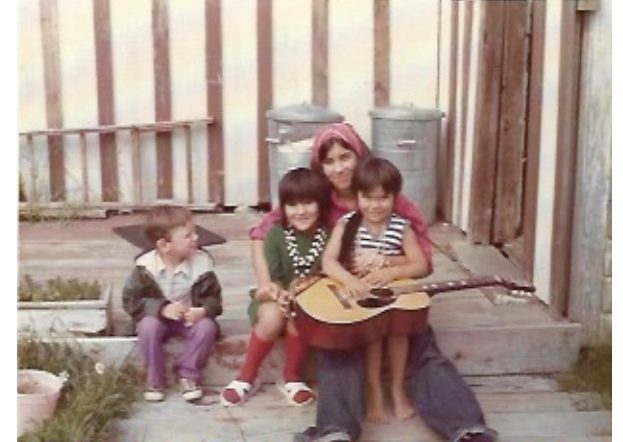
Suzanne with children on the Indigenous Reserve in Cormorant
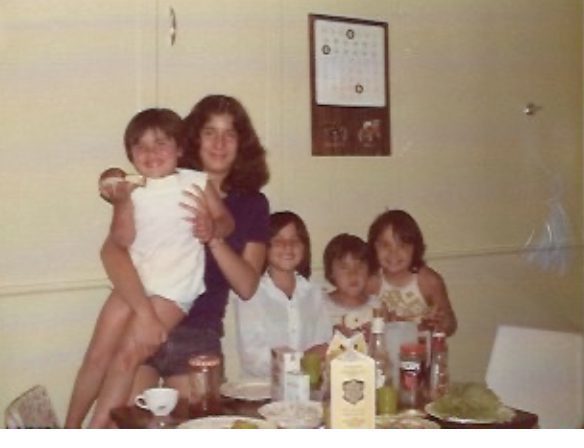
Suzanne with Indigenous children in Blue River, British Colombia
The next summer, when she was 17, she travelled to Blue River in British Columbia to volunteer at another reserve, staying in a teacher’s home on-reserve. She still has letters from the kids who would now be in their 40s and 50s.
Together, the two travel experiences changed her completely. In some ways, she felt even further set apart, because you simply can’t see the world the same way when your eyes have been opened.
“When you’re a loner and you feel alone, you develop an empathy that opens you to understanding that everyone is suffering for one reason or another. My experiences in volunteering were all about being one-on-one and listening to someone else’s needs,” she says. “Then, as an adult, I happened to end up at Mother Teresa’s house, working with nuns again.”
Though Lapensee was baptized Catholic and attended Catholic school, she is more Buddhist in her spiritual philosophy. The opportunity to work with the Sisters of Mercy in Calcutta came at a low point in her life when her personal suffering was high. That, she says, is exactly when the helpers are called to service.
Finding purpose in travel: A second call to service as an adult
The year was 1989. Lapensee was working long hours as an athletic therapist, had even been invited to attend the Francophone Games in Morocco as part of the therapist team. She turned the offer down because she was already serving as an athletic therapist for a national team and would attend a tournament in Malta with the team. She’d been married and separated, with a son that was living with her estranged husband in Ottawa.
“I said to myself: Susie, what’s wrong with you? Why can’t you get it together? Why can’t you feel like you’re a part of the world?” she says. “I wrote a letter to every single person in my life and told them that I was leaving for the tournament and didn’t know when I’d be back. I stopped the lease on my apartment, put all my stuff in storage in somebody’s basement. I knew that everybody would get the letter by the time that I was already gone. I know I upset a lot of people, but if I told anyone my plans, they’d say: You can’t do that. You have a job. You have responsibilities. You have a son. But if I didn’t do this, if I didn’t leave, I wasn’t sure how I was going to exist.”
She left with a canvas backpack. In it was her athletic therapist uniform, a sundress, a t-shirt, a pair of pants and an extra pair of shoes. After the games, she travelled from Malta to Cyprus, to Italy and then Greece. There, she somehow became entangled with a cult and ended up on a flight to Bombay. She took a third-class train from Bombay to Calcutta in abhorrent conditions.
“I was in this big cement house in the middle of a field outside of Calcutta – though I had no clue where I was at the time – with women from all over the world. We’re sleeping on a cement floor with cockroaches climbing on us in the middle of night. The night before we were supposed to go to the desert to meet baba, which means, father, I decided I was getting out of there,” she says. “I packed up and went through the front gates of the compound in the early hours of the morning. There were two young guys guarding the front gates, and I told them I was leaving. They said no. I said yes and kept walking. I had no idea where I was in India.”
Serendipitously, a jam-packed bus with people hanging over every part of it rolled by. Lapensee boarded it with gratitude in her heart and ended up in Calcutta. She’d never seen such a place, with abject poverty everywhere she looked. She found it a difficult place to navigate and thought that perhaps her time in India was done. Setting her sights on Nepal, she decided to get a hotel room for the night.
“You know those ads where the guy comes out of the jungle, a stinking mess, and pulls out his American Express Card and gets this beautiful place? Well, that was me. I took a shower and left my clothes in the other part of the room and when came back into the room, the stench of my clothes was so bad that I couldn’t tolerate it,” she says. “I needed money, and the only way to do that was to go to a bank and get a visa cash advance.”

The always cheerful Sisters of Charity
As she was waiting in an endless line at the bank, she struck up a chat with the people on either side of her – a man from Calcutta and a woman from France. She told them that she needed cash because she wasn’t sure what she was going to do here in Calcutta.
“The man beside me said: Do you need a place to stay? Because I’m leaving for three months and my apartment’s going to be empty, so you can stay there. And the girl beside me from France pipes in: I’m going to Mother Teresa’s house. If you want, I’ll take you there, and you can meet some people. I was sitting between I’ll Give You a Place to Stay and I’ll Take You Where You Need to Go.”
Finding belonging among marginalized humans
Lapensee was about to find what she’d always longed for – belonging – in a place full of the world’s most marginalized humans.
True to her word, the French woman Lapensee had met in the bank brought her to the Sisters of Mercy. A week later, this beautiful woman committed suicide. She’d gone to the bank that day to take out every single penny she had, and then went out into the streets and started distributing it to people. She ran out of money. A few days later, she jumped off of the roof of her hostel. Lapensee gathered with fellow volunteers at her funeral, where everyone was dressed in white.
“I was at the back, and I’m crying. I’m crying because she was there for me. I’m crying because she’s gone,” she recalls. “And the priest looked at me and said: ‘Her soul is safe. There’s no reason to cry. Rejoice in having known her and let go because she’s okay. Always remember that.”
She threw herself into her work supporting the nurses and doctors at a hospice for destitute women. Every morning, there was a Mass at 6 am. It became an anchor for Lapensee – being in the presence of something greater than herself – and found comfort and community in the daily rhythm of her new life. She was taught the basics of administering medical care to the patients.
“You have boiling water, salt, tweezers, and gauze bandages. That’s what you’ve got to work with. You’d walk in, get the patients changed out of their clothing. No incontinence products. There’s a giant cement pond outside with boiling hot water and Dettol. You throw everything in there and get in and stomp on it. Then you rinse everything, including your feet, wring and hang the clothing up to dry. As you can imagine, this takes some time,” she says. “Then you have feeding time, and then begin administering to wounds.”

Wash day at Sisters of Charity

Wound care in progress
One of Lapensee’s charges was a woman they called Nirmala, as most of the hospice residents were not able to communicate their name. She had a beautiful head of long hair, which was shaved off due to lice. She had a large open wound on her neck.
“I care for her daily. I try to feed her, but it’s difficult. The only communication that we had was with our eyes and hand gestures. She had the biggest eyes, and they said everything. Changing her bandages was painful for her. Somewhere in that daily exchange, we developed a strong relationship,” says Lapensee. “I was wearing one of those little blue medals of the Virgin Mary, and one day she looked at it and gestured to it. I said: ‘Oh, you like it?’ Then I took it off and gave it to her.”
Connecting with patients
The next day, Lapensee went to a shop that sold ribbons and found a white one with multi-coloured hearts and brought to Nirmala She put the medal on the ribbon and tied it around her patient’s emaciated wrist. Looking into Nirmala’s eyes, she saw a mixture of sadness, love, and gratitude. Nirmala pointed in the direction of the chapel where Mass was held, and Lapensee helped her make the short trip.
“She couldn’t stay the whole time because she was too weak. I brought her back and said goodbye for the day. The next morning when I came to work, a resident named Rosie said: ‘Your friend’s in the dead house,’” she says. “And there she was, on a slab of concrete, covered with a piece of gauze and her hands folded on top. I took my hand and held my friend’s head. Thought to myself: This is what my life’s about. It was the biggest privilege of my life – to witness her grace. Service is important. I finally found my way to connection and purpose through the gift of sharing and understanding someone else’s pain and suffering.”
Lapensee found the belonging that had so long eluded her in the often-wordless but wholly genuine connections she made with her patients. Her loneliness evaporated in her efforts to help suffering humans feel less lonely and cared for. For those who think such work would become a heavy weight on a person’s soul, Lapensee has another perspective to offer as she speaks of the patients of Mother Teresa’s leprosy centre, and the children that lived with them there.
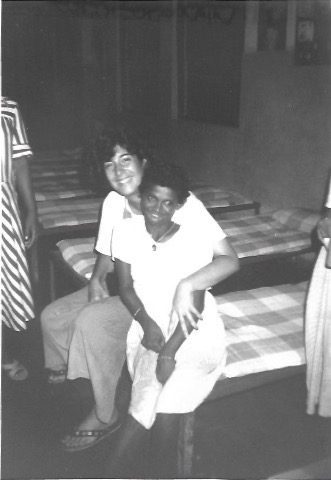
Suzanne with Rosie, one of the hospice residents

Suzanne with a patient at Gandhiji Prem Nivas Leprosy Centre
“The survivors are weaving the cloth for the Sisters of Mercy to make their habits. You had men with big smiles on their faces as they worked a weaving board with just a stump. Doctors are chipping and clipping limbs,” she says. “There was a lot of joy. We’d sing as we washed clothes in the basin. We’d sing as we fed patients. We’d sing as we held the children. Everything we did was with joy. How many times do we remember having this intimate chat with a girlfriend in a time of need, remember how we laughed and cried and held each other and said it’s going to be okay? This is a happy story, and it’s available to everybody.”
After she returned home to Canada after four months in India, Lapensee found it challenging to reacclimate to life in a consumer-driven society. All she could think was how stupid her job fixing tennis elbows was. So, she quit, and became a teacher’s assistant in a kindergarten class while she figured out her next move.
“I became a pedorthist – someone who has specialized training to modify footwear and use supportive devices to address conditions of the feet and lower limbs. I opened my own business, and worked on my own terms, with clients from two years old to 96 years old,” she says. “I loved my job. I could spend as much time with my clients as I wanted. I worked pro bono for lots of people.”
Recently, Lapensee made a big jump in her own life – one that served her after a lifetime of serving others. She and her second husband George moved from Ottawa to their second home: San Miguel de Allende in Mexico. It’s a jump she spoke of wistfully on our Friday Community Calls, one that she was hesitant to make with two ailing parents. We told her that this was her time. Her siblings all agreed. But a helper will always look for and find ways to be of service, wherever they may be.
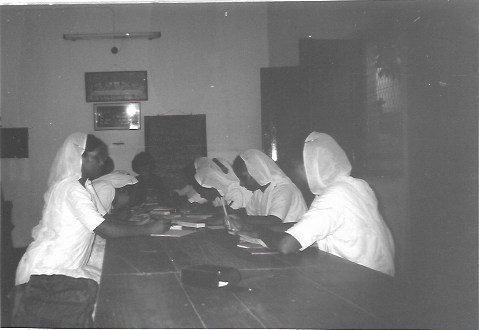
The sisters getting ready for English class with Suzanne as teacher
“I understand my purpose. I’m not going to be JFK, Gandhi, or Oprah. But I’m going to take each person by the hand and I’m going to do what I can in my own small way. I love the whole notion of travelling and being a volunteer. San Miguel has so many NGOs, and I’m a ground zero person. I’m right at the bottom because that’s where you make connections,” she says. “I’ll probably look at helping with water. It’s always going to be an issue here and working directly with women and children is important to me. When I found JourneyWoman, I was in serious isolation, suffering from lack of community in the pandemic. Then I met a group of amazing women. What you need finds you.”
Do you have a Memoir-worthy travel story to tell? Email [email protected]
More Solo Travel Memoirs to Inspire You
Lessons from our Mothers: Karen’s Adventurous Spirit
Solo traveller Karen Barclay shares how she learned to embrace adventure and trust the universe at a young age, inspiring her lifelong travels to Africa, Indonesia and places in between.
Solo Traveller’s Tattoos Tell a Story of Hope, Resilience and Life After Breast Cancer
Solo traveller Christine Pope’s tattoos tell stories of strength, resilience, hope, and life after breast cancer.
Solo Travel Memoirs: How Photography Leads One Woman on New Journeys
Women travellers share the deep interests, hobbies, and passions that they weave into their travels or build entire trips around.




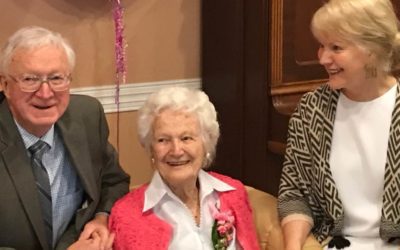
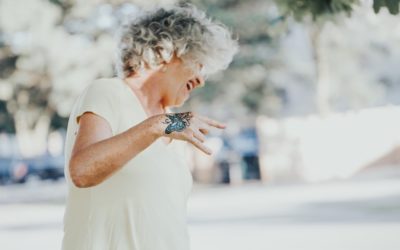
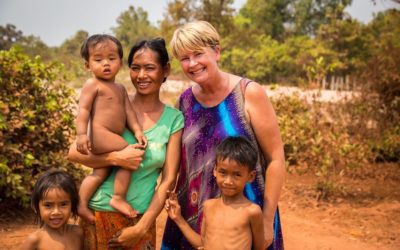
Wonderful, brought tears to my eyes. Through trials, tribulations, and joy; a wonderful selfless woman carrying for others.
Hi Jane, It was my great privileged to be part of a volunteer team of woman , who travelled from around the world and found a sisterhood, in caring for people who needed to be loved . My heart remains full and my tears still flow, when I take myself back to these moments, … nothing but gratitude.
I have read the story of Suzanne Lapensee with great pleasure.
I have met her in the nineties, I think, when she was opening her Pedorthocs practice and we were a graphic studio mear by. We bartered pedorthic services for art. Lol…
She stroke ,e as an intensely compassionate and beautiful person.
I am older now. Living abroad and how i find my way to this site. god only knows.
Beśt Wishes, Suząnne,
Hanna